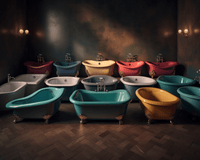The world has a fascinating way of reviving ancient practices in modern wraps. One such practice that’s been capturing hearts, minds, and Instagram feeds is chromotherapy baths. It's not just about colorful bath bombs and aesthetic appeal; there's science and history embedded in those radiant waters. Dive in with us to understand the spectrum of this trending wellness ritual.
Colors of Ancient Healing: The Historical Roots of Chromotherapy
Long before LEDs and spa suites, ancient civilizations were enamored by the healing prowess of colors. In the majestic halls of Egypt, priests believed in using colored minerals, stones, and crystals for healing. Sunlit colored gems were a common sight in their therapeutic rituals. Ancient Greeks, too, celebrated the healing potential of colors; they would diagnose an ailment based on the color and nature of light reflected by the patient's body. In China, traditional treatments often correlated specific colors with particular organs or ailments.
The Science Behind the Spectrum: How Colors Affect Our Mind and Body
Modern science echoes these ancient beliefs to a great extent. It's known that colors can influence our mood and emotions. The blue light, for instance, can suppress melatonin production, keeping us alert, while red hues tend to make us feel cozy and comfortable. On the physiological front, colors can impact heart rate, blood pressure, and respiration. While rigorous scientific research on chromotherapy is still emerging, anecdotal evidence suggests palpable benefits.
Dive into Chromotherapy Baths: The Modern Spa Revolution
Chromotherapy baths are a luxurious fusion of these ancient color principles with modern technology. Today’s spa-goers can submerge in baths that shift through a spectrum of colors, each designed to invigorate, calm, or heal. Advanced systems even allow the water to change color in response to one's heartbeat or music, making the experience truly immersive. The market for such experiences is booming, with wellness resorts and luxury spas leading the charge.
Benefits Beyond Beauty: The Multifaceted Advantages of Colorful Soaks
The allure of chromotherapy baths goes beyond their sheer visual charm. Here's what a chromatic soak might offer:
-
Stress Relief: Blue and green are often associated with calm and relaxation, helping melt away daily anxieties.
-
Improved Sleep: Indigo and darker hues can prepare the body for a restful night by promoting the release of melatonin.
-
Enhanced Mood: Bright yellows and oranges can stimulate serotonin production, acting as natural mood boosters.
-
Skin Rejuvenation: Some believe that the right mix of colors can promote collagen production and combat skin aging.
Crafting Your Own Chromatic Oasis: Tips to Get Started
If a spa visit isn't on the cards soon, worry not. Here’s how to create a chromotherapy experience in the comfort of your home:
-
LED Bath Lights: Invest in waterproof, color-changing LED lights for your bathtub. Many come with remote controls for easy customization.
-
Colored Bath Salts and Oils: These can provide both visual and aromatic benefits. Lavender for relaxation, citrus for invigoration, and rose for romance are popular choices.
-
Safety First: Always ensure any electrical items are designed for bathroom use. Also, patch-test any new bath products to prevent allergic reactions.
Conclusion
As the world gets busier, the quest for relaxation and healing modalities intensifies. Chromotherapy baths, with their blend of ancient wisdom and modern technology, present a vibrant solution. Whether you’re soaking in a high-tech spa or your home bathtub, let the colors infuse your being, and who knows? You might just emerge a little brighter, a tad lighter, and much more colorful.










